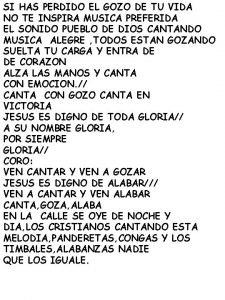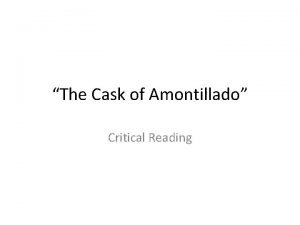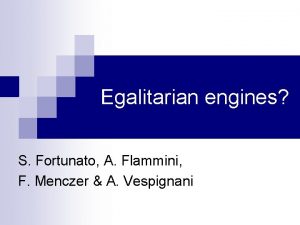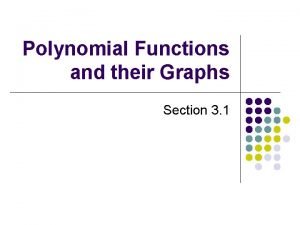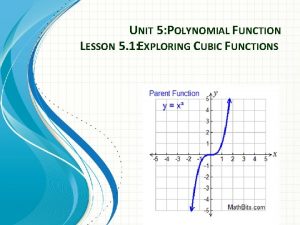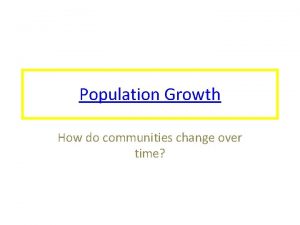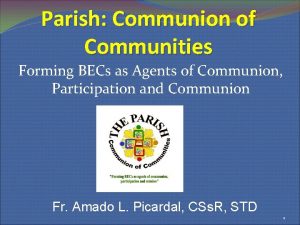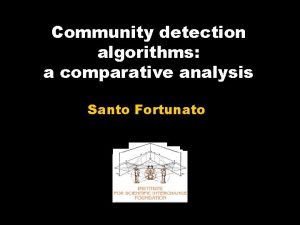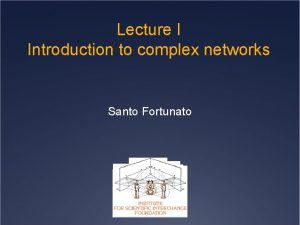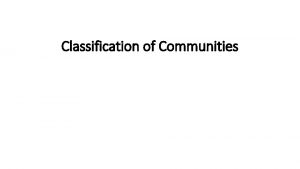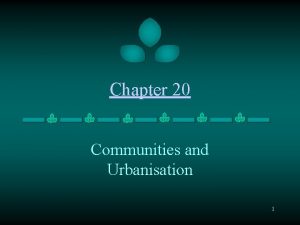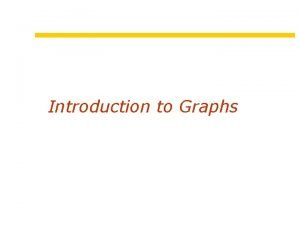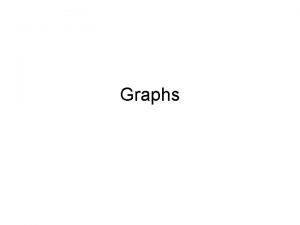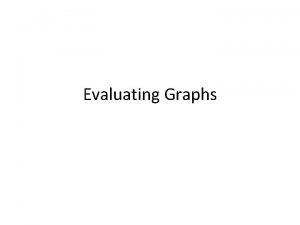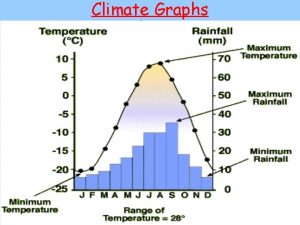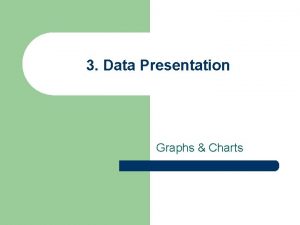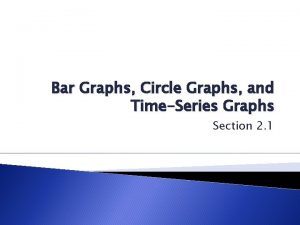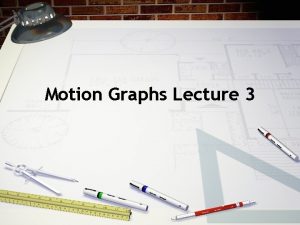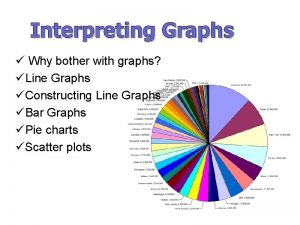Community structure in graphs Santo Fortunato Communities More











































- Slides: 43

Community structure in graphs Santo Fortunato

“Communities” More links “inside” than “outside” Graphs are “sparse”

Metabolic Protein-protein Social Economical

Outline • • Elements of community detection Graph partitioning Hierarchical clustering The Girvan-Newman algorithm New methods Testing algorithms Conclusions

Questions • What is a community? • What is a partition? • What is a “good” partition?

Communities: definition • Local criteria • Global criteria • Vertex similarity In general, communities are indirectly defined by the particular algorithm used!

What is a partition? “A partition is a subdivision of a graph in groups of vertices, such that each vertex is assigned to one group” Problems: 1) Overlapping communities 2) Hierarchical structure

Overlapping communities In real networks, vertices may belong to different modules G. Palla, I. Derényi, I. Farkas, T. Vicsek, Nature 435, 814, 2005

Hierarchies Modules may embed smaller modules, yielding different organizational levels A. Clauset, C. Moore, M. E. J. Newman, Nature 453, 98, 2008

What is a “good” partition?

How can we compare different partitions? ?

Partition P 1 versus P 2: which one is better? Quality function Q Is Q(P 1) > Q(P 2) or Q(P 1) < Q(P 2) ?

Modularity = # links in module i = expected # of links in module i

History • 1970 s: Graph partitioning in computer science • Hierarchical clustering in social sciences • 2002: Girvan and Newman, PNAS 99, 7821 -7826 • 2002 -onward: methods of “new generation”, mostly by physicists

Graph partitioning “Divide a graph in n parts, such that the number of links between them (cut size) is minimal” Problems: 1. Number of clusters must be specified 2. Size of the clusters must be specified

If cluster sizes are not specified, the minimal cut size is zero, for a partition where all nodes stay in a single cluster and the other clusters are “empty” Bipartition: divide a graph in two clusters of equal size and minimal cut size

Spectral partitioning Laplacian matrix L

Spectral properties of L: • All eigenvalues are non-negative • If the graph is divided in g components, there are g zero eigenvalues • In this case L can be rewritten in a block-diagonal form

If the network is connected, but there are two groups of nodes weakly linked to each other, they can be identified from the eigenvector of the second smallest eigenvalue (Fiedler vector) The Fiedler vector has both positive and negative components, their sum must be 0 If one wants a split into n 1 and n 2=n-n 1 nodes, one takes the n 1 largest (smallest) components of the Fiedler vector

Kernighan-Lin algorithm Start: split in two groups At each step, a pair of nodes of different groups are swapped so to decrease the cut size Sometimes swaps are allowed that increase the cut size, to avoid local minima

Hierarchical clustering Very common in social network analysis 1. A criterion is introduced to compare nodes based on their similarity 2. A similarity matrix X is constructed: the similarity of nodes i and j is Xij 3. Starting from the individual nodes, larger groups are built by joining groups of nodes based on their similarity

Final result: a hierarchy of partitions (dendrogram)

Problems of traditional methods • Graph partitioning: one needs to specify the number and the size of the clusters • Hierarchical clustering: many partitions recovered, which one is the best? One would like a method that can predict the number and the size of the partition and indicate a subset of “good” partitions

Girvan-Newman algorithm M. Girvan & M. E. J Newman, PNAS 99, 7821 -7826 (2002) Divisive method: one removes the links that connect the clusters, until the latter are isolated How to identify intercommunity links? Betweenness

Link-betweenness: number of shortest paths crossing a link

Steps 1. Calculate the betweenness of all links 2. Remove the one with highest betweenness 3. Recalculate the betweenness of the remaining edges 4. Repeat from 2

The process delivers a hierarchy of partitions: which one is the best? The best partition is the one corresponding to the highest modularity Q M. E. J. Newman & M. Girvan, Phys. Rev. E 69, 026113 (2004) The algorithm runs in a time O(n 3) on a sparse graph (i. e. when m ~ n)

New methods • • • Divisive algorithms Modularity optimization Spectral methods Dynamics methods Clique percolation Statistical inference

Modularity optimization Goal: find the maximum of Q over all possible network partitions Problem: NP-complete! 1) 2) 3) 4) Greedy algorithms Simulated annealing Extremal optimization Spectral optimization

Greedy algorithm M. E. J. Newman, Phys. Rev. E 69, 066133, 2004 • Start: partition with one node in each community • Merge groups of nodes so to obtain the highest increase of Q • Continue until all nodes are in the same community • Pick the partition with largest modularity CPU time O(n 2)

Resolution limit of modularity

? S. F. & M. Barthélemy, PNAS 104, 36 (2007)

Dynamic algorithms • Potts model • Synchronization • Random walks

Clique percolation G. Palla, I. Derényi, I. Farkas, T. Vicsek, Nature 435, 814, 2005

Testing algorithm • Artificial networks • Real networks with known community structure

Benchmark of Girvan & Newman

Problems • All nodes have the same degree • All communities have equal size In real networks the distributions of degree and community size are highly heterogeneous!

New benchmark (A. Lancichinetti, S. F. , F. Radicchi, ar. Xiv: 0805. 4770) • Power law distribution of degree • Power law distribution of community size • A mixing parameter μsets the ratio between the external and the total degree of each node



Real networks

Open problems • • • Overlapping communities Hierarchies Directed graphs Weighted graphs Computational complexity Testing?

S. F. , C. Castellano, ar. Xiv: 0712. 2716
 Lirik lagu more more more we praise you
Lirik lagu more more more we praise you More more more i want more more more more we praise you
More more more i want more more more more we praise you Poderoso dios dios omnipotente rey de reyes
Poderoso dios dios omnipotente rey de reyes Angeles y serafines dicen santo santo santo
Angeles y serafines dicen santo santo santo Cancion padre nuestro en ti creemos
Cancion padre nuestro en ti creemos Santo santo santo los cielos te proclaman
Santo santo santo los cielos te proclaman Primary ecological succession
Primary ecological succession Antitese
Antitese Que es un hiperbaton
Que es un hiperbaton Que es la sinestesia y ejemplos
Que es la sinestesia y ejemplos Figuras fónicas ejemplos
Figuras fónicas ejemplos Good and bad state graphs
Good and bad state graphs Comparing distance/time graphs to speed/time graphs
Comparing distance/time graphs to speed/time graphs Graphs that enlighten and graphs that deceive
Graphs that enlighten and graphs that deceive Polynomial end behavior chart
Polynomial end behavior chart The cask of amontillado questions and answers
The cask of amontillado questions and answers How does montresor manipulate fortunato
How does montresor manipulate fortunato Characterize montresor. what kind of person is he
Characterize montresor. what kind of person is he At the end of the story what makes montresor feel sick
At the end of the story what makes montresor feel sick Scuola aeronautica bellizzi
Scuola aeronautica bellizzi Dr fortunato barros
Dr fortunato barros Rede brasil de supermercados
Rede brasil de supermercados Ciclista moltiplicato
Ciclista moltiplicato Evan fortunato
Evan fortunato Superhero research project
Superhero research project How did montresor know the house would be empty?
How did montresor know the house would be empty? Evan fortunato
Evan fortunato 5 apples in a basket riddle
5 apples in a basket riddle The more you study the more you learn
The more you study the more you learn Aspire not to
Aspire not to Examples of newton's first law
Examples of newton's first law Knowing more remembering more
Knowing more remembering more More love to thee o lord
More love to thee o lord More choices more chances
More choices more chances Human history becomes more and more a race
Human history becomes more and more a race Linear quadratic and cubic polynomials
Linear quadratic and cubic polynomials Structure in graphs of polynomial functions
Structure in graphs of polynomial functions Evaluate together in community mobilization
Evaluate together in community mobilization Types of education
Types of education Surrey gypsy traveller communities forum
Surrey gypsy traveller communities forum How do communities change over time
How do communities change over time Communion of communities
Communion of communities Metaswitch communities
Metaswitch communities Benedict arnold imagined communities
Benedict arnold imagined communities


